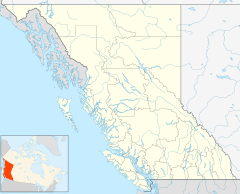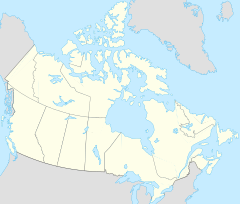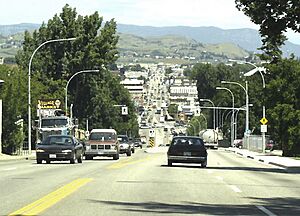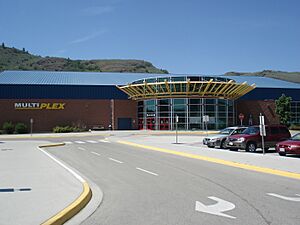Vernon, British Columbia facts for kids
Quick facts for kids
Vernon
|
|||
|---|---|---|---|
|
City
|
|||
| The Corporation of the City of Vernon | |||
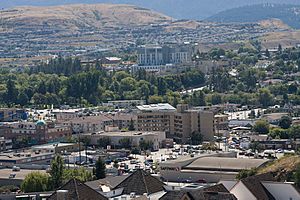
Downtown Vernon in 2011
|
|||
|
|||
| Country | Canada | ||
| Province | British Columbia | ||
| Regional District | North Okanagan | ||
| Incorporated | 30 December 1892 | ||
| Area | |||
| • City | 95.76 km2 (36.97 sq mi) | ||
| • Metro | 1,040.82 km2 (401.86 sq mi) | ||
| Elevation | 380 m (1,250 ft) | ||
| Population
(2021)
|
|||
| • City | 44,519 | ||
| • Density | 461.7/km2 (1,196/sq mi) | ||
| • Urban | 51,896 | ||
| • Metro | 67,086 | ||
| • Metro density | 64.4/km2 (167/sq mi) | ||
| Population counts are taken from the 2021 Canadian census. | |||
| Time zone | UTC−08:00 (PST) | ||
| • Summer (DST) | UTC−07:00 (PDT) | ||
| Forward sortation area |
V1B, V1H, V1T
|
||
| Area code(s) | 250, 778, 236, 672 | ||
| Highways | |||
Vernon is a city located in the Okanagan region of British Columbia, Canada. It is about 440 kilometers (273 miles) northeast of Vancouver. The city is named after Forbes George Vernon, who helped start the Coldstream Ranch nearby. Vernon became an official city on December 30, 1892. In 2021, Vernon had a population of 44,519 people. The larger area, called Greater Vernon, had about 67,086 people. This makes Vernon the biggest city in the Regional District of North Okanagan. People who live in Vernon are called "Vernonites".
Contents
History of Vernon
The area where Vernon is now was first discovered by the Okanagan people. They are a First Nations group and part of the Interior Salish people. They called the area Nintle Moos Chin, which means "jumping over place where the creek narrows." This name refers to a part of Swan Lake that goes through downtown Vernon. The Okanagan people lived around Okanagan Lake and Swan Lake, finding food during different seasons.
Later, the area was called Priest's Valley, which is now an Indigenous reserve. The city then got its current name to honor Forbes George Vernon. He was an important person who helped develop the area.
In 1811, fur traders started exploring the region. Luc Girouard was the first white settler. In 1863, gold was discovered in nearby areas like Cherry Creek. This led to Vernon starting to grow. Many ranches were built, and Centreville, the first downtown area, was formed in 1885. A post office, hotel, store, and school were built that same year. Vernon became a major center for cattle ranches and fruit farms, attracting many British families.
Vernon grew even faster after 1891 when the Canadian Pacific Railway opened in the Okanagan. This railway connected Vernon to other towns. In 1893, a steamboat called the S.S. Aberdeen started running on Okanagan Lake. It connected Vernon to Penticton and other places. Fruit trees were planted, and water was brought to farms through a canal in 1906. In 1908, a military program started, bringing more people to Vernon during World War I and World War II.
Vernon officially became a city on December 30, 1892. A city hall was built in 1903, which also had a fire station and a public reading room. The next year, Vernon was the biggest town in the Okanagan. It was also the first to have a bank and telephones. As more people moved to Vernon, new services became available. A school and the Vernon Jubilee Hospital opened in 1909. Even during World War I, people voted to build a new high school, a sports stadium, and later, a shopping mall and a library.
Getting Around Vernon
Three main highways connect Vernon:
- Highway 97 runs north and south, connecting to Kelowna in the south and Kamloops in the north.
- Highway 97A starts in Vernon and goes north to Armstrong and Enderby.
- Highway 6 ends in Vernon and runs east to Lumby.
These highways have been improved recently. For example, there's a new $22-million interchange where Highway 97 and Highway 6 meet.
Vernon also has a public bus system called Vernon Regional Transit. It's run by the City of Vernon, the District of Coldstream, and the North Okanagan Regional District. This system provides local bus services. For travel outside of Vernon, Ebus offers bus services from the downtown bus terminal.
Vernon has its own airport, the Vernon Regional Airport (YVE). It's mainly used by private planes and doesn't have regular flights. For scheduled flights, people use Kelowna International Airport. It's about 40 kilometers (25 miles) south of Vernon and offers flights to many places.
Vernon's Climate
Vernon has a climate with warm summers and cold winters. Summers can sometimes be hot, and winters are cold but usually milder than in many other parts of Canada. Rain and snow are spread out throughout the year.
| Climate data for Vernon | |||||||||||||
|---|---|---|---|---|---|---|---|---|---|---|---|---|---|
| Month | Jan | Feb | Mar | Apr | May | Jun | Jul | Aug | Sep | Oct | Nov | Dec | Year |
| Record high humidex | 10.5 | 11.0 | 19.1 | 27.0 | 34.0 | 46.0 | 46.2 | 38.4 | 31.9 | 27.0 | 18.9 | 10.8 | 46.2 |
| Record high °C (°F) | 14.5 (58.1) |
13.1 (55.6) |
19.3 (66.7) |
27.8 (82.0) |
33.0 (91.4) |
44.2 (111.6) |
40.1 (104.2) |
38.1 (100.6) |
32.5 (90.5) |
27.4 (81.3) |
19.4 (66.9) |
13.0 (55.4) |
44.2 (111.6) |
| Mean daily maximum °C (°F) | −0.5 (31.1) |
2.1 (35.8) |
8.9 (48.0) |
14.1 (57.4) |
19.2 (66.6) |
23.1 (73.6) |
26.0 (78.8) |
26.4 (79.5) |
20.0 (68.0) |
11.9 (53.4) |
3.9 (39.0) |
−1.3 (29.7) |
12.8 (55.0) |
| Daily mean °C (°F) | −3.0 (26.6) |
−1.0 (30.2) |
4.4 (39.9) |
8.8 (47.8) |
13.4 (56.1) |
17.3 (63.1) |
19.6 (67.3) |
19.9 (67.8) |
14.2 (57.6) |
7.9 (46.2) |
1.3 (34.3) |
−3.5 (25.7) |
8.3 (46.9) |
| Mean daily minimum °C (°F) | −5.4 (22.3) |
−4.0 (24.8) |
−0.2 (31.6) |
3.4 (38.1) |
7.5 (45.5) |
11.4 (52.5) |
13.2 (55.8) |
13.3 (55.9) |
8.4 (47.1) |
3.8 (38.8) |
−1.4 (29.5) |
−5.8 (21.6) |
3.7 (38.7) |
| Record low °C (°F) | −26.7 (−16.1) |
−23.5 (−10.3) |
−18.3 (−0.9) |
−7.2 (19.0) |
0.0 (32.0) |
1.5 (34.7) |
5.5 (41.9) |
4.4 (39.9) |
−1.4 (29.5) |
−17.1 (1.2) |
−29.4 (−20.9) |
−31.0 (−23.8) |
−31.0 (−23.8) |
| Record low wind chill | −35.1 | −26.3 | −23.7 | −13.5 | 0.0 | 0.0 | 0.0 | 0.0 | 0.0 | −15.4 | −23.7 | −38.3 | −38.3 |
| Average precipitation mm (inches) | 32.5 (1.28) |
24.7 (0.97) |
28.5 (1.12) |
31.8 (1.25) |
41.9 (1.65) |
49.4 (1.94) |
42.2 (1.66) |
28.4 (1.12) |
36.7 (1.44) |
27.1 (1.07) |
44.2 (1.74) |
38.2 (1.50) |
425.6 (16.76) |
| Average rainfall mm (inches) | 7.6 (0.30) |
10.1 (0.40) |
24.2 (0.95) |
31.2 (1.23) |
41.9 (1.65) |
49.4 (1.94) |
42.2 (1.66) |
28.4 (1.12) |
36.7 (1.44) |
25.1 (0.99) |
28.1 (1.11) |
8.3 (0.33) |
333.3 (13.12) |
| Average snowfall cm (inches) | 25.0 (9.8) |
14.5 (5.7) |
4.3 (1.7) |
0.6 (0.2) |
0.0 (0.0) |
0.0 (0.0) |
0.0 (0.0) |
0.0 (0.0) |
0.0 (0.0) |
2.0 (0.8) |
16.3 (6.4) |
30.6 (12.0) |
93.3 (36.7) |
| Average precipitation days (≥ 0.2 mm) | 12.1 | 10.6 | 10.5 | 10.5 | 12.8 | 12.0 | 10.5 | 7.7 | 9.1 | 11.2 | 14.6 | 14.2 | 135.8 |
| Average rainy days (≥ 0.2 mm) | 3.2 | 5.2 | 9.1 | 10.4 | 12.8 | 12.0 | 10.5 | 7.7 | 9.1 | 11.0 | 9.9 | 3.2 | 104.0 |
| Average snowy days (≥ 0.2 cm) | 9.7 | 6.6 | 2.2 | 0.4 | 0.0 | 0.0 | 0.0 | 0.0 | 0.0 | 0.4 | 6.5 | 11.9 | 37.6 |
| Average relative humidity (%) | 77.8 | 71.3 | 49.5 | 44.7 | 46.6 | 45.3 | 41.9 | 40.6 | 43.0 | 57.2 | 72.2 | 79.4 | 55.8 |
| Mean monthly sunshine hours | 45.6 | 88.1 | 156.9 | 197.2 | 248.8 | 251.6 | 306.9 | 295.1 | 208.3 | 128.4 | 58.5 | 41.2 | 2,026.6 |
| Percent possible sunshine | 17.2 | 31.2 | 42.7 | 47.8 | 52.0 | 51.4 | 62.2 | 65.7 | 54.8 | 38.4 | 21.5 | 16.4 | 41.8 |
Vernon's Population
| Historical population | ||
|---|---|---|
| Year | Pop. | ±% |
| 1891 | 600 | — |
| 1901 | 802 | +33.7% |
| 1911 | 2,371 | +195.6% |
| 1921 | 3,685 | +55.4% |
| 1931 | 3,937 | +6.8% |
| 1941 | 5,209 | +32.3% |
| 1951 | 7,822 | +50.2% |
| 1956 | 8,998 | +15.0% |
| 1961 | 10,250 | +13.9% |
| 1966 | 11,423 | +11.4% |
| 1971 | 13,283 | +16.3% |
| 1976 | 17,546 | +32.1% |
| 1981 | 19,987 | +13.9% |
| 1986 | 20,241 | +1.3% |
| 1991 | 23,514 | +16.2% |
| 1996 | 31,817 | +35.3% |
| 2001 | 33,494 | +5.3% |
| 2006 | 35,944 | +7.3% |
| 2011 | 38,180 | +6.2% |
| 2016 | 40,116 | +5.1% |
| 2021 | 44,519 | +11.0% |
| Sources: Statistics Canada | ||
In 2021, Vernon's population was 44,519 people. This was a 10.97% increase from 2016. The city has a land area of about 96.43 square kilometers. This means there were about 461.7 people per square kilometer in 2021.
In 2016, the average age in Vernon was 48.4 years old. This is older than the national average of 41.2 years. About 25.5% of the people living in Vernon were 65 or older.
Different Cultures in Vernon
Vernon is home to people from many different backgrounds. According to the 2021 census:
- 84.7% of residents are white.
- 8.0% are visible minorities.
- 7.3% are Indigenous people.
The largest visible minority groups include South Asian (2.4%), Filipino (1.1%), Chinese (1.0%), and Japanese (0.8%).
| Panethnic group | 2021 | 2016 | 2011 | 2006 | 2001 | |||||
|---|---|---|---|---|---|---|---|---|---|---|
| Pop. | % | Pop. | % | Pop. | % | Pop. | % | Pop. | % | |
| European | 36,495 | 84.66% | 33,625 | 86.61% | 32,570 | 89.27% | 31,620 | 89.97% | 29,815 | 90.57% |
| Indigenous | 3,150 | 7.31% | 2,795 | 7.2% | 2,415 | 6.62% | 1,920 | 5.46% | 1,295 | 3.93% |
| South Asian | 1,040 | 2.41% | 730 | 1.88% | 340 | 0.93% | 710 | 2.02% | 980 | 2.98% |
| East Asian | 845 | 1.96% | 730 | 1.88% | 565 | 1.55% | 515 | 1.47% | 540 | 1.64% |
| Southeast Asian | 725 | 1.68% | 520 | 1.34% | 225 | 0.62% | 115 | 0.33% | 130 | 0.39% |
| African | 305 | 0.71% | 105 | 0.27% | 120 | 0.33% | 125 | 0.36% | 55 | 0.17% |
| Latin American | 205 | 0.48% | 155 | 0.4% | 125 | 0.34% | 60 | 0.17% | 40 | 0.12% |
| Middle Eastern | 190 | 0.44% | 120 | 0.31% | 40 | 0.11% | 60 | 0.17% | 45 | 0.14% |
| Other | 155 | 0.36% | 55 | 0.14% | 60 | 0.16% | 10 | 0.03% | 35 | 0.11% |
| Total responses | 43,110 | 96.84% | 38,825 | 96.78% | 36,485 | 95.64% | 35,145 | 97.78% | 32,920 | 98.29% |
| Total population | 44,519 | 100% | 40,116 | 100% | 38,150 | 100% | 35,944 | 100% | 33,494 | 100% |
| Note: Totals greater than 100% due to multiple origin responses. | ||||||||||
Languages Spoken in Vernon
Most people in Vernon speak English as their first language (87.2%). Other common first languages include German (2.1%), French (1.2%), Punjabi (1.2%), and both Russian and Tagalog (0.7% each).
Religions in Vernon
In 2021, over half of Vernon residents (55.1%) reported having no religious affiliation. For those who do, Christianity is the largest religion (40.8%). Other religions practiced include Islam (0.9%), Sikhism (0.8%), Hinduism (0.5%), and Buddhism (0.5%).
Education in Vernon
Vernon is part of School District 22 Vernon. This district has 14 elementary schools and five high schools. The high schools are:
- Vernon Secondary School (VSS)
- Kalamalka High School (Kal)
- Clarence Fulton High School
- W.L. Seaton Secondary (Seaton)
- Charles Bloom Secondary (in Lumby, a town near Vernon)
Vernon Secondary School was updated in the early 2000s. Kalamalka Secondary is near Kalamalka Lake. Fulton Secondary is close to the airport. Seaton High School is off 27th Street. These schools often have friendly competitions, including sports and annual grad pranks.
Vernon also has private schools, like the Vernon Christian School. It has campuses for elementary, middle, and high school students.
For education after high school, Vernon has Okanagan College. This college offers many different courses and degrees. There are also smaller community colleges in Vernon.
Arts and Culture in Vernon
Vernon has many fun events and places for arts and culture:
- Vernon Winter Carnival: Held every winter, this is Western Canada's largest winter carnival. It's the second largest in North America!
- Sunshine Festival: This yearly event takes place downtown. It features live music, craft booths, food trucks, and entertainment for kids.
- Vernon and District Performing Arts Centre: This center hosts many shows, including dance, theater, and children's performances. It also welcomes touring musicians and local talent.
- Powerhouse Theatre: This theater is 60 years old and used to be a power station. Volunteers run it, putting on plays throughout the year.
- Towne Cinema: This movie theater was built in 1929-30 and has a classic Art Deco style. It used to host live shows and banquets. During World War II, it helped entertain troops and collect aluminum for the war effort. Kids could even get a free movie ticket by bringing in an old aluminum pot!
- Vernon Community Arts Centre (VCAC): Located in Polson Park, this center offers art classes and workshops for all ages.
- Creative Chaos: Held every summer in June, this is Western Canada's biggest craft show. Artists from all over sell handmade items like jewelry, chocolates, and unique clothing. There's also a food fair and entertainment.
- Public Art: Vernon has many murals, sculptures, and mosaics. A collection of 28 heritage murals shows the city's history. One famous mural shows Sveva Caetani, an Italian artist who lived in Vernon.
In 2016, Canada's first memorial sculpture for everyone was placed at Vernon Secondary School.
Sports and Fun in Vernon
Vernon is a great place for sports and outdoor activities all year round. In summer, people enjoy the lakes and beaches. In winter, skiing and hockey are popular. It's a favorite spot for tourists from Vancouver and Calgary.
Golfing
Vernon has several golf courses. One famous one is Predator Ridge Resort. It has 36 holes and is known as one of the best public golf courses in Western Canada. It even hosted the Skins Game, a special golf event, in 2000 and 2008.
Skiing
Skiing is a very popular winter sport. Two major ski areas are nearby:
- Silver Star Mountain Resort: This is one of North America's top ski resorts. It also has a large area for cross-country skiing and hosted a World Cup event in 1991.
- Sovereign Lake Nordic Club: This is a world-class place for cross-country skiing, with over 50 kilometers of trails. It hosted a World Cup event in 2005.
Curling
Curling is also popular in Vernon at the Vernon Curling Club. The city has hosted several big curling events, including national championships. In 2008, it hosted its first international event, the 2008 Ford World Women's Curling Championship.
Tennis and Pickleball
Vernon has many tennis courts in beautiful locations. The Vernon Tennis Association helps organize tennis for all skill levels.
Pickleball is a newer sport that is growing fast. The Vernon Pickleball Association has over 500 members. They recently built a roof over their 12 pickleball courts so people can play all year.
Beaches and Mountain Biking
Kalamalka Beach (Kal Beach) is a very popular beach with a large pier for sunbathing and jumping. People also play beach volleyball there in the evenings. Other popular beaches include Kin Beach and Paddle Wheel Park Beach on Okanagan Lake.
Vernon has great places for mountain biking, including Ellison Provincial Park, Kalamalka Lake Park, and Silver Star Mountain Resort.
Rock Climbing and Water Parks
Cougar Canyon is near Vernon and is a popular spot for rock climbing. Ellison Provincial Park is also a good place for cliff jumping and camping. Vernon is also home to Splashdown Vernon, a water park.
Hockey and Lacrosse
Vernon has a strong history in junior hockey. The Vernon Vipers (formerly the Vernon Lakers) are one of the most successful junior teams in Canadian history. They have won the Royal Bank Cup six times, including four times in the 1990s and back-to-back in 2009 and 2010.
| Club | League | Sport | Established | Venue |
|---|---|---|---|---|
| Vernon Vipers | BCHL | Ice hockey | 1961 | Kal Tire Place |
The Vernon Tigers Junior B Lacrosse Club started in 2000. They have won three league titles and two provincial silver medals.
| Club | League | Sport | Established | Venue |
|---|---|---|---|---|
| Vernon Tigers | TOJLL | Lacrosse | 2000 | Kal Tire Place |
City Government
In 2019, the Vernon city council decided to install new public washrooms. These washrooms are designed for everyone in the community to use. They have special features to make sure they are used safely and properly.
The city looked at different designs and decided to have a local company build them. The new washrooms are made of strong stainless steel and have special paint to prevent graffiti. They have a toilet and waterless hand sanitizer inside. There are also slats that allow police to see inside and make sure only one person is using the washroom at a time.
The idea for new public washrooms came from a safety task force in 2018. The first new washroom opened from 7 AM to 9 PM. If these new washrooms work well, they might replace other public washrooms in the city, like the ones near the bus station.
Vernon's Flag
The flag of Vernon was officially adopted in November 2010. Before that, it was flown in Afghanistan by Canadian soldiers, including Gareth Eley, who was from Vernon. He brought the flag back to the mayor during a special ceremony. The mayor said the flag shows the city's "rich" history.
The Vernon City Council decided to frame and display the flag at Vernon City Hall. There is also a crest and shield version of the flag. The flag has a "V" for Vernon, an elk to show the local wildlife, and sheaves of grain to represent the importance of farming. A "horn of plenty" on the flag shows the city's fruit industry.
Famous People from Vernon
Many notable people have connections to Vernon:
- Andrew Allen, a singer-songwriter
- Eric Brewer, a former NHL ice hockey player
- Leone Caetani, a scholar who spent his last years in Vernon
- Raquel Cole, a country music singer
- Josh Dueck, a Paralympic skier who won silver and gold medals
- Andrew Ebbett, an ice hockey player for the Pittsburgh Penguins
- Sonja Gaudet, a Paralympic curler and three-time gold medalist
- Eric Godard, a professional hockey player for the Pittsburgh Penguins
- Leah Goldstein, a professional cyclist, kickboxing champion, and duathlon champion
- Kevin Hill, a snowboarder
- Aaron Hoffman (SonReal), a hip hop artist
- Krista and Tatiana Hogan, famous conjoined twins
- Ken Holland, general manager of the Edmonton Oilers
- Ryan Holmes, CEO of HootSuite
- Larry Kwong, the first Chinese Canadian ice hockey player in the NHL
- Vasek Pospisil, a tennis player and Wimbledon doubles champion
- Daniel Powter, a singer-songwriter known for "Bad Day"
- Laisha Rosnau, a novelist and poet
- TJ Schiller, a professional skier
- Jerred Smithson, a professional hockey player for the Florida Panthers
Images for kids
Sister Cities
Vernon has special "sister city" agreements with these cities around the world:
- Anandpur Sahib, India
- Frankenburg am Hausruck, Austria
- Modesto, United States
- Saint-Lambert, Canada
- Tavullia, Italy
- Tome, Japan
Freedom of the City
The "Freedom of the City" is a special honor given by Vernon to important people and military groups.
Individuals
- Kenneth Mark Holland: October 26, 2021
Military units
- Vernon Army Cadet Summer Training Centre: August 4, 1979
- British Columbia Dragoons: May 10, 2008
See also
 In Spanish: Vernon (Columbia Británica) para niños
In Spanish: Vernon (Columbia Británica) para niños



